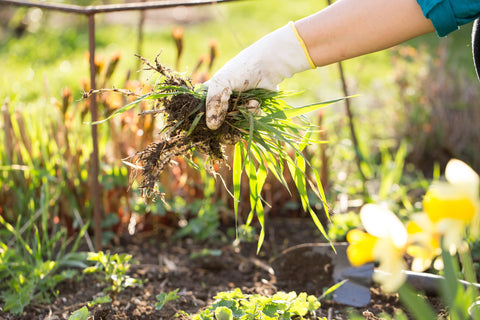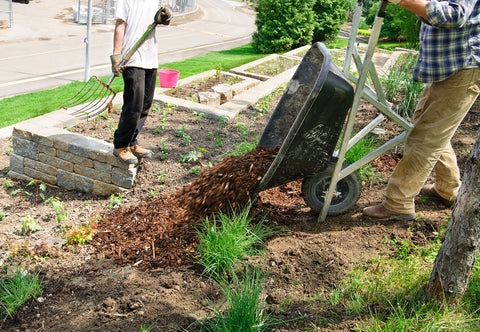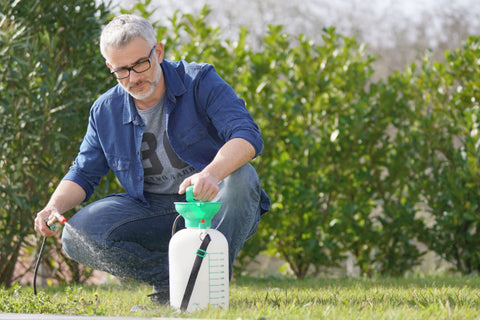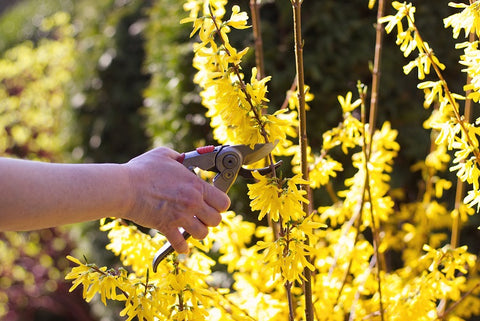Preparing Your Garden Before Easter
One of the great things about the time of year before Easter is the fact that spring is near and just around the corner. Some of the days leading up to Easter are beginning to warm up and motivate us to get outside and begin to get our gardens, trees, shrubs and grass ready for summer. Here are a few ideas that may help you organize your chores. I can provide you with a comprehensive list of gardening chores to tackle before Easter. Here are some essential tasks you might consider to ensure your garden is in top shape for the holiday:
Preparing the Garden Beds:
Weeding: Remove any weeds that have sprouted to prevent them from competing with your plants for nutrients and sunlight. When it comes to removing weeds easily and effectively, there are several methods you can consider. One popular approach is using glyphosate, a selective weed killer that can efficiently eliminate weeds with just one spray, preventing their regrowth. Another simple yet effective method involves pouring boiling water over the weeds and then covering them with black plastic for a few days. This technique helps to kill the weeds and prepare your garden for planting. For ongoing weed management, regular pulling of weeds as soon as they sprout is crucial. Spending a few minutes daily or every other day to remove the weeds by hand can prevent them from spreading and taking over your garden. Additionally, trimming the tops of weeds with scissors or a specialized trimming tool can be an easy way to control weed growth in larger areas. Remember, when pulling weeds by hand, use a weed puller tool with a narrow, forked end to dig around the weed's roots effectively and reach into tight spaces. By following these simple yet effective methods, you can keep your garden weed-free and maintain a healthy growing environment for your plants.

Mulching: Apply a layer of mulch to help retain moisture, suppress weeds, and regulate soil temperature. When mulching a garden in the spring, timing is crucial for optimal plant health and growth. It's advisable to wait until the ground has had a chance to warm up and dry out somewhat before applying mulch. This allows the soil to benefit fully from the warming temperatures and prevents issues like mold or rot that can arise from mulching too early. Experts recommend mid- to late-spring as the ideal time to mulch a garden, as this is when the soil starts to warm up after winter frosts. Proper mulching helps retain moisture, suppress weeds, and regulate soil temperature, creating a conducive environment for plants to thrive. It's essential to avoid tightly compacted mulch, as this can hinder soil aeration and water absorption. Instead, opt for a light layer of mulch that allows the soil to breathe while still providing insulation and weed control. While mulching every year is common practice, it's crucial to assess the need based on how well the plants have filled in the space. If the garden is densely planted, you may not need to mulch every year, but if gaps are present, adding mulch can help maintain soil health and plant growth.

By following these dos and don'ts of mulching in the spring, gardeners can promote healthy plant growth, reduce weed competition, and create a visually appealing garden landscape.
Aeration: If your soil is compacted, aerate it to improve airflow, water drainage, and nutrient absorption for healthier plant roots. Liquid aeration is a popular method for maintaining lush and healthy lawns without the hassle of traditional core aeration. This innovative technique involves using liquid solutions that help improve soil structure, increase water retention, and enhance nutrient uptake by the roots of the grass. Liquid lawn aeration is praised for its ease of application and quick results, making it an attractive option for homeowners looking to revitalize their lawns. One key benefit of liquid aeration is its ability to soften compacted soil, allowing grassroots to penetrate deeper and access vital nutrients more effectively. By creating space in the soil and improving water penetration, liquid aeration promotes healthier root growth and overall turf health. Additionally, liquid aerators are known for their long-lasting effects, with results that can endure for months after application. While traditional core aeration remains effective for addressing thatch issues, liquid aeration offers a convenient alternative that eliminates the need for unsightly cores to break down on the lawn's surface. Whether applied through a hose attachment or a backpack sprayer, liquid aerators have garnered positive feedback from users who have observed noticeable improvements in soil quality and grass vitality over time. In conclusion, liquid lawn aeration emerges as a promising solution for maintaining vibrant and resilient lawns, offering a blend of convenience, effectiveness, and lasting results that appeal to homeowners seeking a simple yet impactful lawn care treatment.

Pruning and Trimming:
Prune Dead Branches: Trim away dead or damaged branches from trees and shrubs to promote new growth and maintain plant health. Pruning trees and shrubs is a crucial task that not only enhances the appearance of your landscape but also promotes plant health and growth. To effectively prune trees and shrubs, follow these guidelines:
Timing: Prune trees and shrubs during their dormant season, typically in late winter or early spring before new growth begins. This timing allows wounds to heal quickly without affecting the plant's vitality.
Tools: Use sharp, clean pruning tools such as hand pruners, loppers, and pruning saws to make clean cuts that promote healing. Disinfect tools between plants to prevent the spread of diseases.
Technique: Start by removing dead, diseased, or damaged branches. Then, prune for shape and structure, cutting back to healthy outward-facing buds or branches. Avoid leaving stubs, as they can attract pests and diseases.
Size Matters: When pruning, consider the size and growth habit of the plant. Remove any crossing or rubbing branches to improve airflow and reduce the risk of damage.
Safety: Be mindful of your safety when pruning trees and shrubs. Wear gloves, safetyglasses, and sturdy footwear. Use a ladder or pole pruner for hard-to-reach branches.
Consult an Expert: If you are unsure about how to prune specific trees or shrubs, consult a local arborist or gardening expert for guidance tailored to your region and plant species.
By following these pruning guidelines, you can maintain healthy, visually appealing trees and shrubs that thrive in your landscape.
Trim Overgrown Plants: Cut back overgrown shrubs or perennials to encourage bushier growth and improve the overall appearance of your garden.

Soil Care:
Soil Testing: Conduct a soil test to determine its pH level and nutrient content. Adjust the soil accordingly by adding amendments like compost or fertilizer. Testing your soil in the spring is crucial for ensuring the health and vitality of your plants and garden. As the winter frost melts away, the spring season marks the ideal time to assess the nutrient levels, pH balance, and overall quality of your soil. By conducting a soil test early in the spring, you can identify any deficiencies or imbalances that may hinder plant growth and development throughout the growing season. Moreover, spring soil testing provides valuable insights for tailoring your fertilization and amendment strategies to meet the specific needs of your plants. Knowing the exact nutrient requirements of your soil allows you to make informed decisions about which fertilizers or organic amendments to apply, leading to healthier plants, better yields, and improved overall garden performance. Additionally, spring soil testing sets a baseline for monitoring changes in soil composition over time, enabling you to track improvements and adjust your gardening practices accordingly. In essence, testing your soil in the spring is a proactive measure that promotes successful gardening outcomes and long-term soil health.
Composting: Start a compost pile or bin to recycle kitchen scraps and garden waste into nutrient-rich compost for your plants.
Planting and Transplanting:
Start Seeds Indoors: Begin sowing seeds indoors for vegetables, herbs, or flowers that require an early start before the last frost date.
Transplant Seedlings: If you've started seeds indoors, transplant the seedlings into larger containers or directly into the garden once they have developed a few sets of leaves.
Pest Control:
Inspect for Pests: Check plants for signs of pest infestations such as chewed leaves, yellowing foliage, or webbing. Take appropriate measures to control pests organically if necessary.
Set Up Trap Plants: Plant trap crops like marigolds or nasturtiums to lure pests away from your main crops and protect them from damage.
Lawn Care:
Mowing: Begin mowing your lawn regularly, adjusting the mower height to the recommended level for your grass type.
Overseeding: Fill in bare patches on the lawn by overseeding with grass seed to promote a lush and healthy turf.
Watering:
Establish Watering Schedule: Create a watering schedule based on the needs of your plants, taking into account factors like weather conditions and soil moisture levels.
Install Drip Irrigation: Consider installing drip irrigation systems to deliver water directly to plant roots, conserving water and reducing evaporation.
Fertilizing:
Apply Slow-Release Fertilizer: Feed your plants with a balanced, slow-release fertilizer to provide them with essential nutrients for healthy growth.
Fertilize Bulbs: If you have spring-flowering bulbs, fertilize them before they bloom to support their growth and enhance flowering. Plant Food is a great way to get those bulbs started.
Maintenance Tasks:
Clean Garden Tools: Clean and sharpen your gardening tools to ensure they are ready for use and to prevent the spread of diseases between plants.
Inspect Hoses and Irrigation Systems: Check hoses, sprinklers, and irrigation systems for leaks or damage, repairing or replacing them as needed.
Seasonal Plant Care:
Plant Cool-Season Vegetables: Sow seeds or plant seedlings of cool-season vegetables like lettuce, spinach, and peas for a bountiful spring harvest.
Deadhead Flowers: Remove spent blooms from flowering plants to encourage continuous blooming and maintain a tidy appearance in the garden.
By tackling these gardening chores before Easter, you can set the stage for a vibrant and flourishing garden that will be a joy to behold during the holiday season. If you need further guidance or specific recommendations, feel free to ask!








